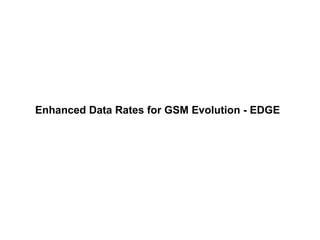
GSM_evolution
- 1. Enhanced Data Rates for GSM Evolution - EDGE
- 2. Enhanced Data rates for GSM Evolution (EDGE) (also known as Enhanced GPRS (EGPRS), or IMT Single Carrier (IMT-SC), or Enhanced Data rates for Global Evolution) is a backward- compatible digital mobile phone technology that allows improved data transmission rates, as an extension on top of standard GSM. EDGE is considered a 3G radio technology and is part of ITU's 3G definition. EDGE was deployed on GSM networks beginning in 2003— initially by Cingular (now AT&T) in the United States.
- 3. EDGE is standardized by 3GPP as part of the GSM family, and it is an upgrade that provides more than three-fold increase in both the capacity and performance of GSM/GPRS networks. It does this by introducing sophisticated methods of coding and transmitting data, delivering higher bit-rates per radio channel.
- 4. EDGE can be used for any packet switched application, such as an Internet connection. EDGE-delivered data services create a broadband internet-like experience for the mobile phone user. High bandwidth data applications such as video services and other multimedia benefit from EGPRS' increased data capacity.
- 5. Evolved EDGE continues in Release 7 of the 3GPP standard providing reduced latency and more than doubled performance e.g. to complement High-Speed Packet Access (HSPA). Peak bit-rates of up to 1Mbit/s and typical bit-rates of 400kbit/s can be expected.
- 6. Technology EDGE/EGPRS is implemented as a bolt-on enhancement for 2G and 2.5G GSM and GPRS networks, making it easier for existing GSM carriers to upgrade to it. EDGE/EGPRS is a superset to GPRS and can function on any network with GPRS deployed on it, provided the carrier implements the necessary upgrade.
- 7. EDGE requires no hardware or software changes to be made in Global System for Mobile Communications core networks. EDGE compatible transceiver units must be installed and the base station subsystem needs to be upgraded to support EDGE. If the operator already has this in place, which is often the case today, the network can be upgraded to EDGE by activating an optional software feature. Today EDGE is supported by all major chip vendors for both GSM and WCDMA/HSPA.
- 8. Transmission techniques In addition to Gaussian minimum-shift keying (GMSK), EDGE uses higher- order PSK/8 phase shift keying (8PSK) for the upper five of its nine modulation and coding schemes. EDGE produces a 3-bit word for every change in carrier phase. This effectively triples the gross data rate offered by GSM. EDGE, like GPRS, uses a rate adaptation algorithm that adapts the modulation and coding scheme (MCS) according to the quality of the radio channel, and thus the bit rate and robustness of data transmission. It introduces a new technology not found in GPRS, Incremental Redundancy, which, instead of retransmitting disturbed packets, sends more redundancy information to be combined in the receiver. This increases the probability of correct decoding.
- 9. EDGE can carry a bandwidth up to 236.8 kbit/s (with end-to-end latency of less than 150 ms) for 4 timeslots (theoretical maximum is 473.6 kbit/s for 8 timeslots) in packet mode. This means it can handle four times as much traffic as standard GPRS. EDGE meets the International Telecommunications Union's requirement for a 3G network, and has been accepted by the ITU as part of the IMT-2000 family of 3G standards. It also enhances the circuit data mode called HSCSD, increasing the data rate of this service. EDGE is part of ITU's 3G definition and is considered a 3G radio technology.
- 10. EDGE modulation and coding scheme (MCS) EDGE is four times as efficient as GPRS. GPRS uses four coding schemes (CS-1 to 4) while EDGE uses nine Modulation and Coding Schemes (MCS-1 to 9).
- 11. Evolved EDGE Evolved EDGE improves on EDGE in a number of ways. Latencies are reduced by lowering the Transmission Time Interval by half (from 20 ms to 10 ms). Bit rates are increased up to 1 MBit/s peak bandwidth and latencies down to 800 ms using dual carriers, higher symbol rate and higher-order modulation (32QAM and 16QAM instead of 8-PSK), and turbo codes to improve error correction. And finally signal quality is improved using dual antennas improving average bit-rates and spectrum efficiency. EDGE Evolution can be gradually introduced as software upgrades, taking advantage of the installed base. With EDGE Evolution, end-users will be able to experience mobile internet connections corresponding to a 500 kbit/s ADSL service. GPRS is the predecessor of EDGE.
- 12. Networks The Global mobile Suppliers Association (GSA) states that, as of January 2009, there were 413 GSM/EDGE networks in 177 countries, from a total of 441 mobile network operator commitments in 184 countries.